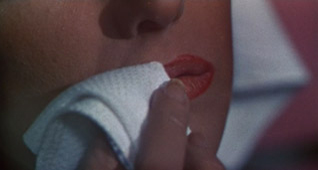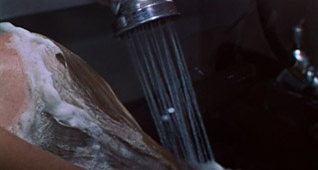Viewing Toy Story 2 Through a Vertigo Lens
By Jason Haggstrom, February 25, 2012
 The films of Pixar are heavily populated with references to movies of the past, to the films most beloved by the studio’s many writer/directors. Consider WALL-E‘s villainous robot AUTO whose devilish red-eye brings to mind HAL 9000 from 2001: A Space Odyssey; or The Incredibles‘ hilarious Edna as a doppelganger for real life costume designer Edith Head; or even A Bug’s Life whose entire plot—a defenseless village hires warriors to protect itself from bandits—is lifted right out of Seven Samurai. Most of these homages are created as comedy. They’re cinematic in-jokes for the initiated, connections that simply make one smile. But Pixar’s films are far greater than the sum of their homages. Most often they are great films, the kind that reveal hidden nuances with each additional viewing. Toy Story 2 is one such film.
The films of Pixar are heavily populated with references to movies of the past, to the films most beloved by the studio’s many writer/directors. Consider WALL-E‘s villainous robot AUTO whose devilish red-eye brings to mind HAL 9000 from 2001: A Space Odyssey; or The Incredibles‘ hilarious Edna as a doppelganger for real life costume designer Edith Head; or even A Bug’s Life whose entire plot—a defenseless village hires warriors to protect itself from bandits—is lifted right out of Seven Samurai. Most of these homages are created as comedy. They’re cinematic in-jokes for the initiated, connections that simply make one smile. But Pixar’s films are far greater than the sum of their homages. Most often they are great films, the kind that reveal hidden nuances with each additional viewing. Toy Story 2 is one such film.
Toy Story 2 is littered with subtle homages (and many not so subtle), most notably to well known sci-fi epics such as The Empire Strikes Back ("No, Buzz, I am your father"), Jurassic Park ("Objects in mirror are closer than they appear"), and 2001: A Space Odyssey (by way of Richard Strauss’s "Also Sprach Zarathustra"). But some of Toy Story 2‘s pop culture references exist as more than simple homage. Its numerous links to Alfred Hitchcock’s Vertigo, for instance, resonate beyond the similarities of image or sound to connect back to that film’s themes as well.
In Toy Story 2‘s first act, Woody is placed on Andy’s highest shelf after the seem of his arm is accidentally torn. This shelf is the place where broken toys disappear, never to be seen again. And Woody knows it. Stuck on that shelf and fearing the worst, Woody experiences a Vertigo-esque nightmare that reveals his fear of abandonment, a theme that runs through all the Toy Story films (here’s the entire clip). What begins as a dream turns to dread through the filmmakers’ use of a dolly zoom (i.e., the camera zooms in while tracking backwards, distorting the perspective), the very shot made famous in Vertigo‘s famous staircase sequence. In Toy Story 2, the effect distorts the bedroom, and Andy with it.
But the dolly zoom was just the primer, a way to tip off to astute viewers of what is to come as Woody’s fall to the floor becomes a psychedelic fall from reality.
Pay attention to the change in the film’s score, especially once Woody lands in the trashcan (here’s the clip). The swirling repetition of strings and sudden appearance of ominous low brass imply Vertigo‘s main musical theme without completely duplicating it.
Both dreams end with the dreamer in limbo: Scottie forever falling in a sea of empty, white space, and Woody being buried in a trashcan, never to be played with or embraced by a child again.
Woody is later repaired in a sequence that shows him being cleaned, having his worn paint re-applied, and losing the loving defacement of "Andy" under a fresh layer of brown. The montage is a recreation of the scene in Vertigo where Judy is remade into the object of Scottie’s desire. Judy’s garish makeup is wiped away, her hair is dyed platinum, and her nails are polished to a glossy sheen. Each phase of the transformation brings her one step closer to becoming Madeline once again. In both films, the character in question has their true identity burnished away by someone else’s idea of perfection. Woody is now "for display only;" he’s an object to be observed and admired, but never loved.
But the scenes of Woody’s nightmare and of his restoration are just the two most prominent examples of Vertigo homage in Toy Story 2. A common approach in academic film criticism is the practice of not just extracting meaning from a film, but of applying a theory to it. How different does a film read when seen through a specific lens? How does a film appear through the lens of feminist theory? What about Marxist theory? If we apply a Vertigo lens to all of Toy Story 2 we find all sorts of visual connections to Hitchcock’s masterpiece. Here’s Woody’s view from Al’s apartment, not unlike the drop that Scottie sees while on the stepladder in Midge’s.
And I love the symmetry of these images, the beginning of Woody’s story and the end of Scottie’s.
And here we can see in this shot that Al’s car is an amalgamation of classic cars of the 1950s and not unlike the very car that Scottie drives. And, of course, Vertigo‘s Scottie also drives around in Vertigo while wearing a chicken costume… Er… No.
So, am I really suggesting that Toy Story 2 owes a great debt to Vertigo. Hardly. Some of these connections are clearly deliberate, and some are most likely not. Really, viewing the film through a Vertigo lens—attempting to find any connection back to Hitchcock’s film—is just another way to view it.
The best films—and make no mistake, Toy Story 2 is a great film—don’t just elicit repeat viewings, but hold up to the scrutiny brought on by time and to the the changing perspectives of their viewers. When we return to great films, we often approach them through a different lens. Each viewing informs the next, and allows us to see things in ways we never saw them before. I’m not really the type of viewer who goes out of his way to play "spot the reference," but when you notice something particular in a film it becomes very hard to unsee it. In Toy Story 2, I can’t help but see allusions to Alfred Hitchcock’s Vertigo. Whether they are intended or not the connections are there, and their exploration can lead to a greater appreciation of the film.
The gang at Press Play recently ran a contest that mocked the use of Vertigo‘s music cue, "Scene d’Amour," in The Artist. Press Play readers were encouraged to follow The Artist‘s lead and place that same musical cue into scenes from other films. My entry:
![]()



























3 Comments
By Tiel Lundy on August 2, 2012 at 3:54 PM
Bravo, Jason!
I love the close visual and audio readings you’ve generated here. The side-by-side screen shots are at once compelling AND hilarious. Cinephiles love having their film knowledge and devotion tested by being able to identify subtle and not-so-subtle homages to prior films. (Since we’re talking about Vertigo, one of my favorite homages is Tom Tykwer’s film Run Lola Run.) But I think you’ll agree that while that might be a fun game, it doesn’t always tell us a whole lot about either film.
So, what I’m wondering is this: Why Vertigo and not another great film like, say, Rear Window, or Citizen Kane? I quite like your observation that Toy Story 2 picks up Vertigo’s theme about the fear of abandonment, and I guess I’m interested in hearing more. Furthermore, what are the implications or consequences of taking a psychological suspense drama and pastiching it in an animated children’s comedy?
By Jason Haggstrom on August 2, 2012 at 7:59 PM
Like I said in the piece, I’m not typically a “spot the reference” kind of viewer. Usually, that type of analysis doesn’t really go anywhere beyond the level of “hey, look what I noticed.” But the motivation here was exactly as you describe: the homage is funny, and they use it as to further their themes. I love how, if you know the reference, the homage works as shorthand for expressing so much more than what is directly in the scene. It pulls all of Vertigo into mind. And so I guess that is exactly the answer to “Why Vertigo?” rather than something else. The gang at Pixar really loves to show their film knowledge, but they also do such a good job at making the homages work within the context of whatever film they’re making. Maybe we will see a Rear Window or Citizen Kane reference in one of their films one of these days. But if they go there, I hope they do it with the same purpose that they did with these Vertigo homages.
On that theme about the fear of abandonment… well, I’ve got a pile of notes for a future essay on the Toy Story series that I wrote while doing this essay. But I’m so notoriously slow at getting my writing projects done that I have no idea when I’ll finally drum it back up and write the thing. (I’m still trying to finish up one of the five or so others that are half written right now!) Just a matter of time before it finds it’s way to the top of the pile!
By Tiel Lundy on August 7, 2012 at 3:11 PM
I don’t think you’re slow at all. On the contrary, I’m always amazed at how productive you are!
I’ll eagerly await your essay-in-progress!
Leave a Comment